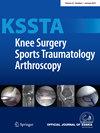High tibial osteotomy and concurrent medial meniscus root repair provides improved objective outcomes compared to high tibial osteotomy alone for knee osteoarthritis: A systematic review
Abstract
Purpose
High tibial osteotomy (HTO) is a cornerstone treatment for medial compartment osteoarthritis (OA) in active patients with varus deformity. However, managing the combination of varus alignment and the medial meniscus posterior root tears (MMPRT) remains controversial. The purpose of this systematic review was to synthesise data from recent comparative studies and evaluate whether adding an MMPRT repair to an HTO enhances outcomes, particularly with respect to meniscal healing, cartilage preservation, and patient function.
Methods
We systematically searched MEDLINE, Embase, Scopus, and Web of Science through April 2025 for studies comparing isolated HTO with HTO plus MMPRT repair. Outcomes included meniscal healing, cartilage status, and patient-reported measures. Risk of bias was assessed using ROBINS-I.
Results
Six studies (506 knees) were included, with 260 undergoing HTO plus MMPRT repair. The reported mean difference in complete meniscus healing ranged from 12.5% to 40% in the HTO plus MMPRT repair group, while it ranged from 0% to 15% in the isolated HTO group. Joint space width (JSW) was reported in three studies, with one study reporting a significant improvement in the HTO plus MMPRT repair group. Cartilage outcomes were superior in three of six studies. One study reported significant functional improvement with a concomitant repair. Despite methodological heterogeneity, all studies had a moderate risk of bias.
Conclusions
While short-term subjective outcomes were similar between isolated HTO and HTO plus MMPRT repair, objective measures, namely higher meniscal healing rates and more stable cartilage scores, consistently favoured the combined approach. In the younger population, even short-term subjective outcomes showed significant improvements along with objective measures and return to sports. Long-term clinical trials are required to determine if these biological advantages translate into a delay in the progression of knee osteoarthritis, particularly in younger, active patients.
Level of Evidence
Level III, systematic review.





 求助内容:
求助内容: 应助结果提醒方式:
应助结果提醒方式:


